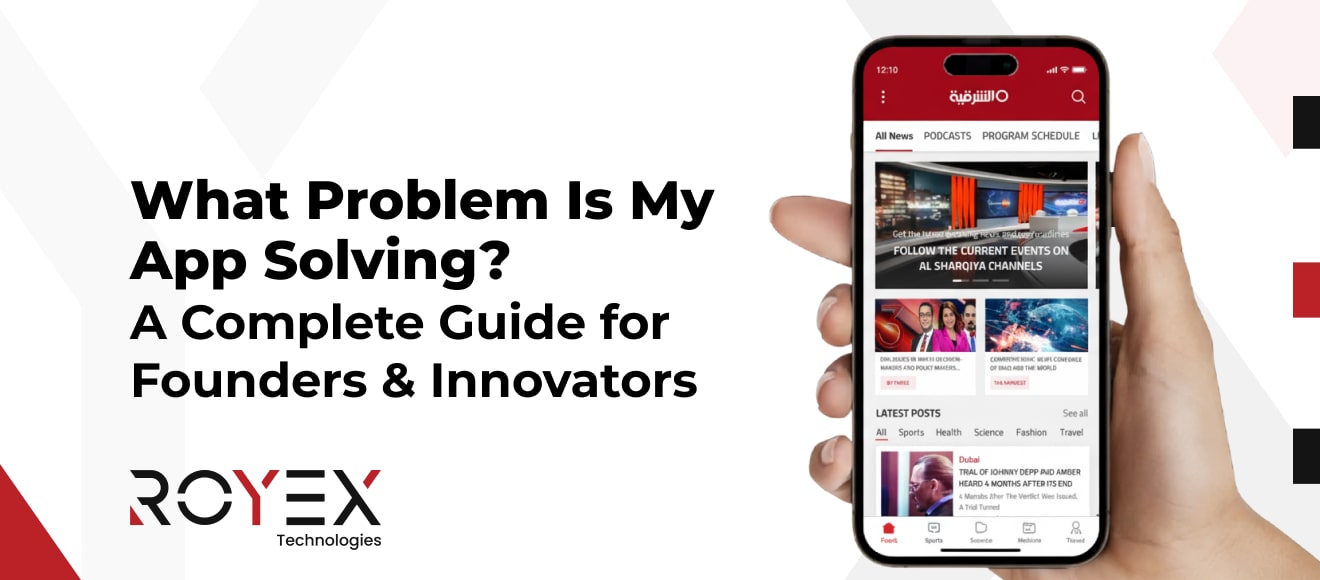
What Problem Is My App Solving? A Complete Guide for Founders & Innovators
Series Note: Based on common questions asked by our customers before developing mobile apps, we have listed most of the questions and answers in detail for each of the questions. This article is part of our series “Mobile App Journey: Things You Must Know.”
Every successful app starts with a clear, sharp answer to a deceptively simple question:
“What problem is my app solving?”
This is not just a philosophical exercise. It’s the foundation of your product roadmap, your pitch to investors, your marketing strategy, and ultimately, your survival in a crowded app marketplace.
Without clarity on the core problem, apps drift into feature bloat, burn money solving the wrong issues, or fade into obscurity. According to CBInsights’ startup post-mortem study, 42% of failed startups cited ‘No market need’ as the top reason for failure.
In this guide, we’ll explore in depth:
- How to identify and frame the problem your app is solving
- Different frameworks to analyze user pain points
- Methods to validate that the problem is real and worth solving
- Industry statistics that underscore the importance of problem clarity
- Examples of how leading apps defined their “problem statements”
- Pros and cons of focusing narrowly vs broadly on problems
- Why partnering with Royex Technologies helps ensure you start with the right problem
The App Economy: Why Problem-Solving Is Non-Negotiable
The mobile app industry is massive—and fiercely competitive.
- Global mobile app revenues are projected to reach $673.8 billion by 2027, up from $420.7 billion in 2022.
- The average smartphone user uses 9–10 apps daily and 30 apps monthly. Yet there are over 8.9 million apps across iOS and Android stores.
- Research shows that 25% of apps are abandoned after a single use. Most users uninstall because the app doesn’t deliver a compelling solution to a real need.
These numbers prove one thing: only apps that solve urgent, real-world problems survive.
Step 1: Define the “Job to Be Done”
A great way to reframe “problem” is the Jobs-to-Be-Done (JTBD) theory. People don’t “buy apps”; they “hire” them to get jobs done.
Example:
- Users don’t want a “fitness tracking app.”
They want to stay accountable to their health goals. - Users don’t want a “language learning app.”
They want to feel confident speaking on a trip or in business.
By defining the job, you anchor your app to a problem that resonates emotionally and practically.
Step 2: Identify User Pain Points
There are four primary categories of problems apps solve:
- Functional Problems
Tangible, practical issues.
-
- Example: Uber solved the problem of hailing unreliable taxis.
- Example: Dropbox solved the problem of file access across devices.
- Example: Uber solved the problem of hailing unreliable taxis.
2. Emotional Problems
Feelings like stress, boredom, lack of confidence.
-
- Example: Headspace addresses anxiety and mindfulness.
- Example: Instagram originally addressed the insecurity of “bad photo quality” by offering easy filters.
- Example: Headspace addresses anxiety and mindfulness.
3. Social Problems
The need for connection, recognition, or community.
-
- Example: WhatsApp solved the problem of expensive SMS and cross-border communication.
- Example: TikTok solved the problem of discoverability for creators.
- Example: WhatsApp solved the problem of expensive SMS and cross-border communication.
4. Aspirational Problems
Helping users achieve future goals.
-
- Example: Duolingo helps users reach long-term skill aspirations.
- Example: Khan Academy helps learners achieve educational ambitions.
- Example: Duolingo helps users reach long-term skill aspirations.
Step 3: Research & Validation
User Interviews
Ask potential users:
- “What’s the most frustrating part of [X process]?”
- “How are you solving it today?”
- “What would an ideal solution look like?”
Market Analysis
Use tools like Statista, App Annie (Data.ai), and Google Trends to check if the problem is large and growing. For instance, mobile health app downloads grew by 54% in 2020 as health monitoring became a mainstream need.
Competitor Analysis
Study reviews of existing apps. Look for repeated complaints (“too slow,” “poor design,” “expensive”). Every 1-star review is a problem statement waiting to be solved.
Step 4: Framing the Problem Statement
A powerful problem statement follows this structure:
[User persona] struggles with [problem] when [context]. Current solutions are [limitations], which leads to [negative consequences]. Our app solves this by [solution].
Example:
Busy urban commuters struggle with finding affordable, healthy meals during short lunch breaks. Current solutions are fast-food apps with long prep times or unhealthy menus, which leads to stress and poor nutrition. Our app solves this by curating fast, healthy meal options deliverable within 15 minutes.
Step 5: Test if the Problem Is Worth Solving
Not every problem is worth your time. Use these filters:
- Frequency: How often do users face it?
- Intensity: How painful is it emotionally or practically?
- Willingness to Pay: Would they spend money/time to fix it?
- Market Size: How many people have this problem?
Stat insight: Only 0.5% of consumer apps are financially successful—usually because they solve high-frequency, high-pain problems that people pay for.
Step 6: Align Problem with Monetization
Your monetization strategy should tie directly to the problem.
- If solving convenience problems → people will pay subscriptions (Spotify, Netflix).
- If solving entertainment problems → ads and in-app purchases work (Candy Crush, TikTok).
- If solving critical workflow problems → enterprises pay licenses (Slack, Asana).
Pros and Cons of Narrow vs Broad Problem Definitions
Narrow Problem Focus
Pros: Easier to build MVP, clear marketing, quick validation.
Cons: Risk of small market, limited growth.
Broad Problem Focus
Pros: Larger market, potential for ecosystem.
Cons: Harder to design early product, higher risk of feature bloat.
Best practice: Start narrow, expand once traction proves value.
Case Studies: Problem Statements Behind Iconic Apps
- Airbnb
Problem: Travelers struggle to find affordable, authentic lodging.
Solution: Connect them with local hosts offering homes. - Uber
Problem: Taxis are unreliable, scarce, and expensive.
Solution: Instant ride-hailing via GPS + cashless payment. - Calm
Problem: Modern users are overwhelmed by stress.
Solution: Guided meditations and sleep aids for relaxation. - Zoom
Problem: Traditional video conferencing was clunky and unstable.
Solution: Simple, fast, reliable video meetings.
Statistics on Why Problem-Solving Matters
- 42% of startups fail due to lack of market need.
- 64% of features in apps are rarely or never used, proving many don’t address core problems.
- Apps with a clear value proposition achieve 2x higher retention rates than those with vague problem definitions.
- The global app abandonment rate after first use is 25%. A poorly defined problem is the root cause.
Why Royex Is the Best Company for Mobile App Development
At Royex Technologies, we believe problem definition is the beating heart of successful app development. Here’s why working with us helps you nail it:
- Discovery Workshops
We run structured sessions with clients to uncover the true user problem—not just what’s on the surface. - Domain Expertise
With experience across e-commerce, fintech, health, transport, and education, we understand patterns of user problems across industries. - Prototyping & Validation
Our team builds wireframes, mockups, and MVPs that test problem hypotheses before you invest heavily. - Market Insights
Operating from Dubai, we combine global perspective with local market knowledge across MENA, GCC, and Asia. - Proven Track Record
With 500+ projects delivered since 2013, Royex has repeatedly helped startups and enterprises translate vague ideas into apps that solve meaningful problems.
Conclusion
The app ecosystem rewards clarity of purpose. Before asking “What features should I build?” or “How will I monetize?”, you must first answer:
“What problem is my app solving?”
Get this right, and every other decision—design, tech stack, marketing, business model—falls into place. Get it wrong, and no amount of polish can save you.
By blending disciplined problem discovery, validation, and iterative development, you increase your chances of building not just an app, but a solution people return to daily.
And with partners like Royex Technologies, you gain the strategic guidance and technical execution needed to ensure your app solves the right problem, the right way.
We are a leading mobile app development company in Dubai, that provides innovative solutions for small, medium, and large-scale companies. We specialize in responsive web development, mobile app development, CRM integration, AI solutions for website & mobile applications, and many more. Our extensive experience in mobile app development will help you to take your business to a high level.
Check our portfolio to see our previous works. Contact us via email at info@royex.net or call us at +971566027916. To get started with us.
Sources
- CBInsights – Top Reasons Startups Fail (2024 update)
- TechCrunch – Only 0.5% of consumer apps succeed (2023 report)
- Localytics – App abandonment after first use statistics (2023)
- Statista – Mobile app revenue worldwide forecast (2022–2027)
- Business of Apps – How many apps are in the stores? (2024)
- Product Marketing Alliance – Value proposition and retention studies (2023)
- App Annie (Data.ai) – Health app growth in 2020 (2021 report)
Standish Group / Johnson – 64% of features rarely used (via Scrum.org)





